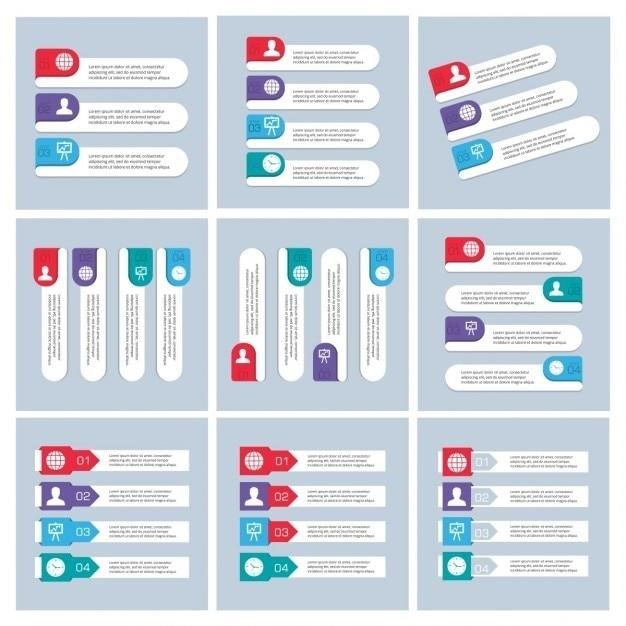
UPS 10 Point Commentary⁚ A Guide to Safe Driving Practices
The UPS 10 Point Commentary is a set of safe driving practices that all UPS drivers are required to follow. The commentary is designed to help drivers stay safe and avoid accidents. The 10 points are⁚ clearing intersections, stopped in traffic, count 1-2-3, pulling from the curb, following distance, eye lead time, scan steering wheels, stale green lights, pulling from the curb, and use of mirrors and gauges.
Clearing Intersections⁚ The Importance of Scanning
The first point of the UPS 10 Point Commentary emphasizes the critical importance of scanning your surroundings when approaching, navigating, or exiting an intersection. This practice goes beyond simply looking left and right; it’s about gaining a comprehensive understanding of your driving environment.
When you approach an intersection, don’t just focus on the traffic lights. Instead, scan ahead, looking left, right, and then back to the left again. This systematic scanning helps you identify potential hazards like pedestrians, cyclists, or vehicles that may be entering the intersection.
Think of it as getting the “big picture.” By actively scanning your surroundings, you’re not just looking for immediate threats; you’re also anticipating potential dangers and preparing yourself to react accordingly. This proactive approach to driving helps ensure a safer and more efficient passage through intersections.
Stopped in Traffic⁚ Maintaining Safe Distance
The second point of the UPS 10 Point Commentary focuses on the importance of maintaining a safe distance from the vehicle in front of you when stopped in traffic. This practice, known as “leaving a car length,” is crucial for ensuring a safe and controlled stop, allowing you to react quickly to any sudden changes in traffic conditions.
When you come to a stop behind another vehicle, ensure that there is at least one car length of space between your vehicle and the one in front of you. This distance provides you with a buffer zone, allowing you to react appropriately if the vehicle ahead suddenly brakes or moves forward.
In addition to leaving a car length, it’s also essential to apply your parking brake. This helps prevent your vehicle from rolling forward unintentionally, especially on inclines or when stopped on slippery surfaces. By practicing this safe stopping technique, you’re not only protecting yourself but also those around you.
Count 1-2-3⁚ Creating a Space Cushion
The third point of the UPS 10 Point Commentary emphasizes the importance of creating a space cushion when following another vehicle, especially when starting up at intersections. This technique involves counting “one, two, three” after the vehicle in front of you has begun to move, allowing you to establish a safe following distance.
By counting “one, two, three,” you’re essentially establishing a time gap between your vehicle and the one ahead. This time gap provides you with a crucial buffer zone, allowing you to react appropriately if the vehicle ahead suddenly brakes or changes lanes.
The “count 1-2-3” technique promotes safe and defensive driving. It helps you avoid tailgating, which can lead to rear-end collisions, and allows you to anticipate and adjust to changes in traffic flow. Furthermore, it ensures you maintain a safe distance, allowing you to maneuver your vehicle effectively and avoid potential hazards.
Pulling from the Curb⁚ Safe and Effective Maneuvers
The fourth point in the UPS 10 Point Commentary focuses on safe and effective maneuvers when pulling from the curb. This step emphasizes the importance of utilizing signals, mirrors, and visual checks to ensure a smooth and hazard-free transition into traffic.
Before pulling from the curb, the driver is instructed to activate their left turn signal, ensuring other vehicles are aware of their intention. A thorough check of the rearview and side mirrors is then crucial to identify any oncoming traffic or obstacles in their path. The driver should also visually scan the area to the left, particularly the blind spot, to confirm no pedestrians, cyclists, or vehicles are approaching.
Finally, drivers should pay close attention to the tail swing of their vehicle, particularly in tight spaces or when turning. Understanding the vehicle’s swing radius helps prevent collisions with parked vehicles or obstacles. This comprehensive approach ensures a safe and efficient pull from the curb, minimizing the risk of accidents and promoting a smooth flow of traffic.
Following Distance⁚ Maintaining Safe Following Time
The fifth point in the UPS 10 Point Commentary emphasizes the crucial importance of maintaining a safe following distance, ensuring ample time and space for reacting to unforeseen situations on the road. This principle, known as “following time,” is a fundamental element of defensive driving.
The commentary dictates a specific following time based on the vehicle’s speed. For speeds up to 30 mph, a following time of 4-6 seconds is required. This means that the driver should allow a sufficient distance to cover the same ground as the vehicle in front in 4-6 seconds.
However, for speeds exceeding 30 mph, a longer following time of 6-8 seconds is mandated. This increased distance provides a greater buffer for reaction time and allows for safer braking in case of sudden stops or unexpected events.
Adhering to these prescribed following times ensures that drivers have adequate time to react to sudden braking, changing lanes, or other unpredictable events. This proactive approach significantly minimizes the risk of rear-end collisions and promotes a safer driving experience for all parties involved.
Eye Lead Time⁚ Staying Ahead of the Game
The sixth point of the UPS 10 Point Commentary emphasizes the importance of “eye lead time,” a crucial aspect of defensive driving that involves looking ahead and anticipating potential hazards. It’s about staying ahead of the game, anticipating potential problems before they arise, and reacting proactively to maintain control and safety on the road.
Eye lead time is not merely about looking straight ahead; it’s about scanning the road ahead for potential hazards, such as vehicles slowing down, pedestrians crossing, or road obstructions. This proactive approach allows drivers to identify potential problems early and adjust their driving accordingly, ensuring a smoother and safer journey.
The recommended eye lead time for UPS drivers is between 8-12 seconds. This means that drivers should be able to see and anticipate what’s happening 8-12 seconds ahead of their vehicle. This allows them to react appropriately to changing traffic conditions, potential hazards, and unexpected events.
By maintaining a proper eye lead time, drivers can anticipate situations, adjust their speed, and make informed decisions to avoid potential accidents. This practice significantly contributes to a safe and efficient driving experience, ensuring the well-being of the driver and other road users.
Scan Steering Wheels⁚ Identifying Occupied Vehicles
The seventh point of the UPS 10 Point Commentary emphasizes the importance of “scanning steering wheels” as a crucial aspect of defensive driving, particularly when navigating busy urban areas or congested traffic. This practice involves observing the steering wheels of vehicles parked at the curb to determine whether they are occupied.
By scanning steering wheels, drivers can quickly assess whether parked vehicles are likely to suddenly pull out into traffic, potentially causing a collision. This proactive approach allows drivers to anticipate potential hazards and adjust their driving accordingly, ensuring a smoother and safer journey.
The rationale behind this practice is simple⁚ a vehicle with a driver behind the wheel presents a greater risk of sudden movement than an unoccupied vehicle. Drivers are more likely to be alert and ready to pull out into traffic, while an empty vehicle poses less of a risk. By identifying occupied vehicles, drivers can be more cautious and anticipate their potential actions, reducing the likelihood of a collision.
The act of scanning steering wheels is a simple yet effective habit that can significantly enhance driver safety. It encourages drivers to be more observant, anticipate potential hazards, and react proactively, making the roads safer for everyone.
Stale Green Lights⁚ The Importance of a Point of Decision
The eighth point of the UPS 10 Point Commentary focuses on the concept of “stale green lights” and the importance of establishing a “point of decision.” This crucial practice is designed to promote safe driving at intersections where the traffic signal has been green for an extended period.
A stale green light is one that has been green for a while, and the driver is unsure if it is about to change. In such situations, a driver must establish a “point of decision,” which is an imaginary line set up between the vehicle and the crosswalk. This line represents the point at which the driver will stop if the light changes.
By establishing a point of decision, drivers can react quickly and safely if the light changes to yellow or red. This proactive approach helps avoid potential collisions caused by sudden braking or entering an intersection just as the light turns red. The point of decision helps drivers to be more prepared and anticipate potential changes in traffic signals.
The practice of establishing a point of decision promotes defensive driving by encouraging drivers to be more aware of their surroundings and anticipate potential hazards. It helps drivers stay in control of their vehicles and react safely to changing traffic conditions, ensuring a smoother and safer driving experience.
Pulling from the Curb⁚ Communicating in Traffic
The ninth point in the UPS 10 Point Commentary emphasizes the importance of effective communication while pulling from the curb and merging back into traffic. This point underscores the significance of clear signaling and using appropriate maneuvers to ensure the safety of both the driver and other road users.
When pulling from the curb, drivers are instructed to activate their left turn signal, check their mirrors to confirm the lane is clear, and visually scan for any potential hazards. It is crucial to look left to ensure a safe path before moving out. Additionally, drivers should be mindful of the vehicle’s tail swing while maneuvering, especially in tight spaces or when vehicles are parked close to the curb.
Merging back into traffic requires drivers to use their horn or lights to communicate with other vehicles. This helps alert nearby cars of their intentions and allows for a smoother integration into the flow of traffic. By employing these communication methods, drivers can minimize the risk of collisions or sudden braking maneuvers, creating a safer environment for all road users.
The 10 Point Commentary stresses the importance of using visual and auditory cues to alert other drivers, fostering a culture of proactive communication and safe driving. It encourages drivers to be mindful of their surroundings and act with caution when merging back into traffic, ensuring a smooth and safe driving experience for all.
Use of Mirrors and Gauges⁚ Maintaining Awareness

The final point in the UPS 10 Point Commentary focuses on the crucial role of mirrors and gauges in maintaining driver awareness and ensuring a safe driving experience; This point emphasizes the importance of constantly monitoring these tools to stay informed about the vehicle’s surroundings and its operational status.
The use of mirrors is essential for drivers to maintain situational awareness. By regularly checking the rearview mirrors, side mirrors, and blind spots, drivers can monitor the movement of other vehicles, pedestrians, and potential hazards. This practice allows them to react promptly to unexpected situations and avoid collisions. The 10 Point Commentary stresses the need for frequent mirror checks, even when seemingly clear of obstacles.
In addition to mirrors, drivers are advised to keep a close eye on the vehicle’s gauges. These instruments provide vital information about the vehicle’s performance, including speed, fuel level, engine temperature, and warning lights. By regularly monitoring the gauges, drivers can identify any potential issues or malfunctions that could compromise safety.
The 10 Point Commentary emphasizes that the use of mirrors and gauges is an ongoing process, not a one-time action. By consistently utilizing these tools, drivers can stay alert, anticipate potential hazards, and maintain a safe and efficient driving practice.
